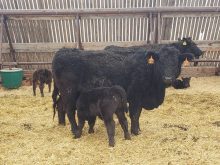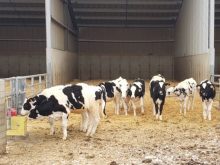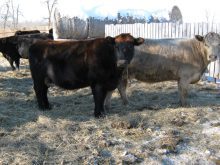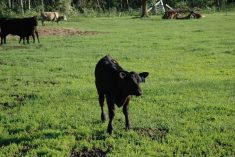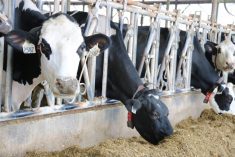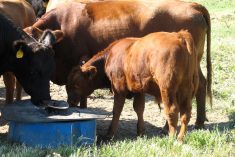It’s long been recognized that lactating dairy cows have a specific requirement for biotin which may not be met by natural synthesis in the rumen. Much research in the early 2000s demonstrated biotin supplements to lactating dairy diets yields respectable improvements in hoof health and better milk production. With the advent of many available feed additives, adding biotin to lactating dairy diets has been pushed into the background in dairy nutrition. In light of this, dairy producers should reassess the benefits of adding biotin into their lactation diets.
Read Also

Harvest wraps up and fall work begins
At the Eppich famly ranch in western Saskatchewan, the fall harvest was successful with few breakdowns, cows and calves have been sorted and a new tractor has arrived
Although no actual biotin requirement for dairy cows has been established, it’s speculated that specific biotin-making bacteria in the rumen produce about three to five mg daily. Together with some natural biotin found in many dairy feeds (such as distillers dried grains), that likely takes care of all vital biological functions such as milk production requirements as well as what’s required by rumen microbes, including the bugs that produce biotin in the first place.
Some dairy nutritionists point out that this recognized supply is not always a reliable source of essential biotin. They say the bioavailability of biotin from dairy feed ingredients as well as synthetic man-made biotin is less than 50 per cent of their respective concentrations.
Furthermore, natural biotin concentrations found in rumen fluid decrease as soon as the forage-to-concentrate ratio decreases, such as found in early-lactation dairy diets. An American university study in the 1990s showed that biotin rumen synthesis was cut in half in a lactation diet when its forage/concentrate ratio was decreased from 80 to 50 per cent forages.
At about the same time, 20 mg per head/day of supplemental biotin was deemed necessary by similar dairy research in order to maintain “adequate biotin status,” as found in respective blood levels in healthy lactating dairy cows.
Two main functions
Since biotin is a water-soluble B-vitamin, this 20 mg dosage encompasses a wide range of metabolic processes, yet its real and practical potential in dairy nutrition really comes down to its two main functions in the dairy cow’s body. First, biotin is a co-factor in many of the cow’s enzyme systems and metabolic processes that drive energy, fat and protein metabolism. Second, it plays a specific role in the process of kernatinization, which transforms epithelial tissue in strong hoof-horn material in cattle.
As a dairy nutritionist, I have used this 20 mg/head/day recommendation since it first appeared in mainstream dairy nutrition. My experience is that it should be added like any other feed additive to a well-balanced lactation diet with a solid foundation of:
- Effective forage fibre: All my lactation TMRs contain a minimum amount of neutral detergent fibre (NDF) of 27-28 per cent with 70 to 80 per cent of that coming from the forages. Therefore a 60 per cent forage to 40 per cent concentrate ratio of the entire TMR is maintained.
- Available energy: I draw upon a healthy rumen microbe population to release this dietary energy, largely from the fermentation of forage fibre (née carbohydrates) and grain-starch energy.
- Non-fibre carbohydrates: The NFC portion of the diet (containing starch) should be limited to 35-37 per cent of the total diet. Starch, which comprises a significant portion of NFC, should be targeted at 21-25 per cent of the diet, dm.
With a good dairy nutrition base in place, it was always my understanding that such biotin supplements may take up to three to four months to yield a positive milk response, and eight to 12 months of a similar biotin treatment for a positive hoof response. I found it was quicker and easier to see positive results with other “hoof-strengthening” nutrients such as adding organic zinc to dairy diets.
Despite a lack of visibility, I am confident that adding biotin to my own lactation feeding programs was successful in contributing an improvement in hoof heath and better overall milk production of these dairy herds.
It’s a matter of having confidence in the available science that dictates: biotin supplements’ primary objective is to meet the dairy cow’s true biotin requirement, which is often not covered by microbial biotin production. In this way, it is like any other essential nutrient in a well-balanced lactation diet, which promotes good health and optimum performance in high-producing dairy cows.




